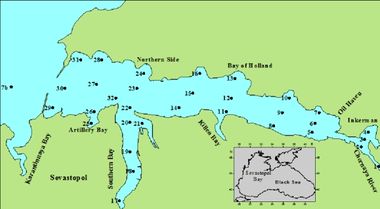Sevastopol Bay
CASE description
The Bay of Sevastopol is one of rare natural inland harbours at the coast of Crimea on the Black Sea that has being serving as a marine shelter and residence for sequencing human civilizations for over 25 centuries. This bay had also served as place for intensive fishing and harvesting of other marine biological resources before the fleet related activities almost completely destroyed its ecosystems. Inner part of the Bay is a site, where regular hypoxic/anoxic events and consequences can be traced to study the effects of anthropogenic/industrial pollution and water exchange. The outer part of the bay is still rather clean and can be considered a reference site with rather natural conditions in the water column and with potentially hypoxic conditions in the upper bottom sediments. Currently, navy activities are modest and the Sevastopol Bay is a place for a big and intensively growing seaport (the total length of place for ship docking and mooring in ~11 km), ship docking, sea-land transportation of various goods. The population of Sevastopol is about 400,000 permanent residents, but this population can easily double on summer time. The major part of municipal and industrial sewage waters (~10,000 m3 per day) loaded to the bay from ~30 sewers without or after minimal treatment.
ICZM phase
Establishment
Main coastal issues
- Eutrophication and water pollution
- Biological diversity loss
- Climate change impacts
Objectives
- To provide information about ICZM tools;
- To improve the knowledge of the coastal zone
End Products
Coastal Information System
(web portal: legal arrangements, environmental status and assessment, atlas)
Tools foreseen to be developed and used
Indicators - LEAC - Scenarios
Training needs
LEAC – Scenarios
CASE Responsible
Sergey Konovalov - Marine Hydrophysical Institute, Ukrainian National Academy of Sciences, sergey@alpha.mhi.iuf.net
Elaboration: Stefano Soriani, Fabrizia Buono, Monica Camuffo, Marco Tonino, University Ca’ Foscari of Venice.


